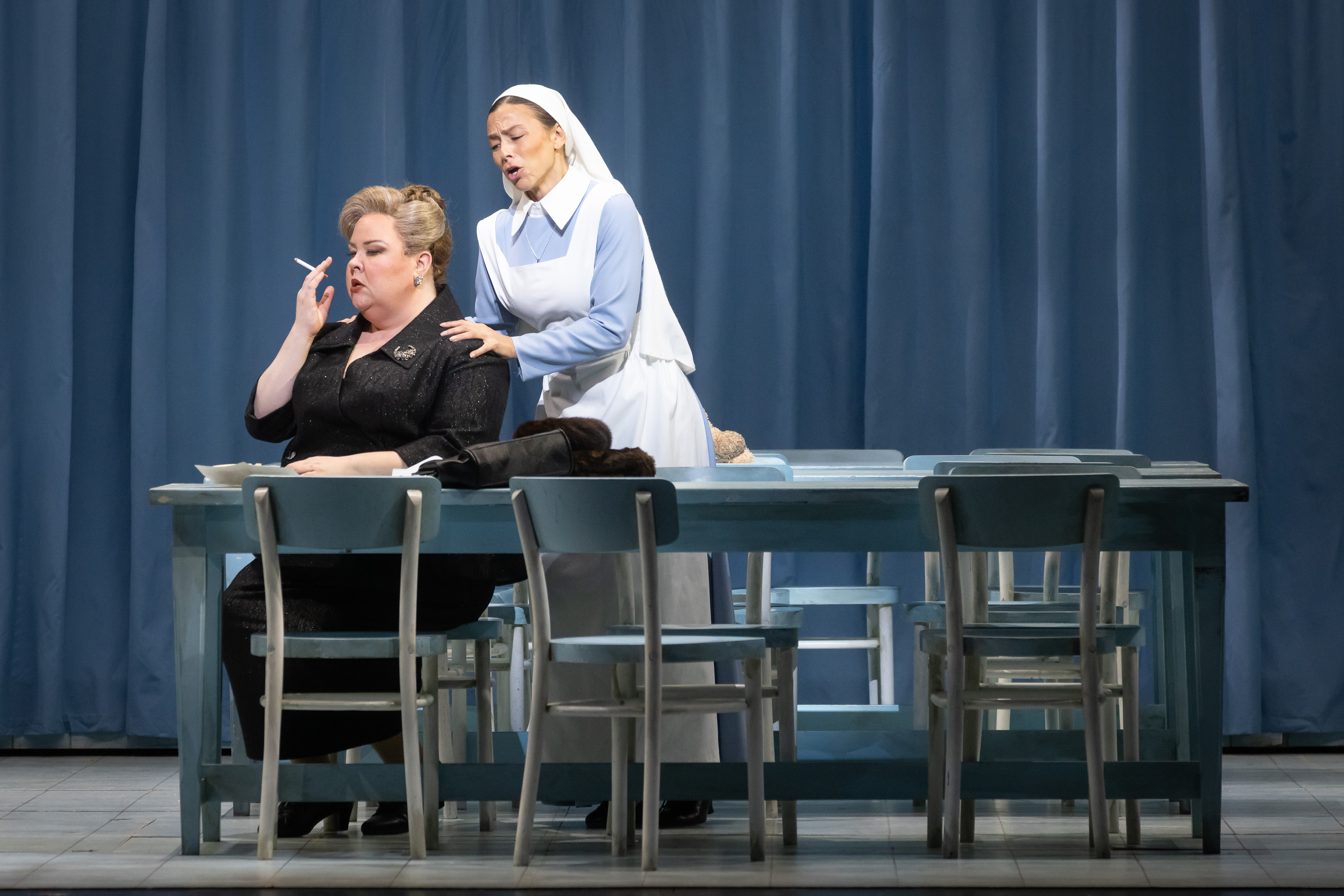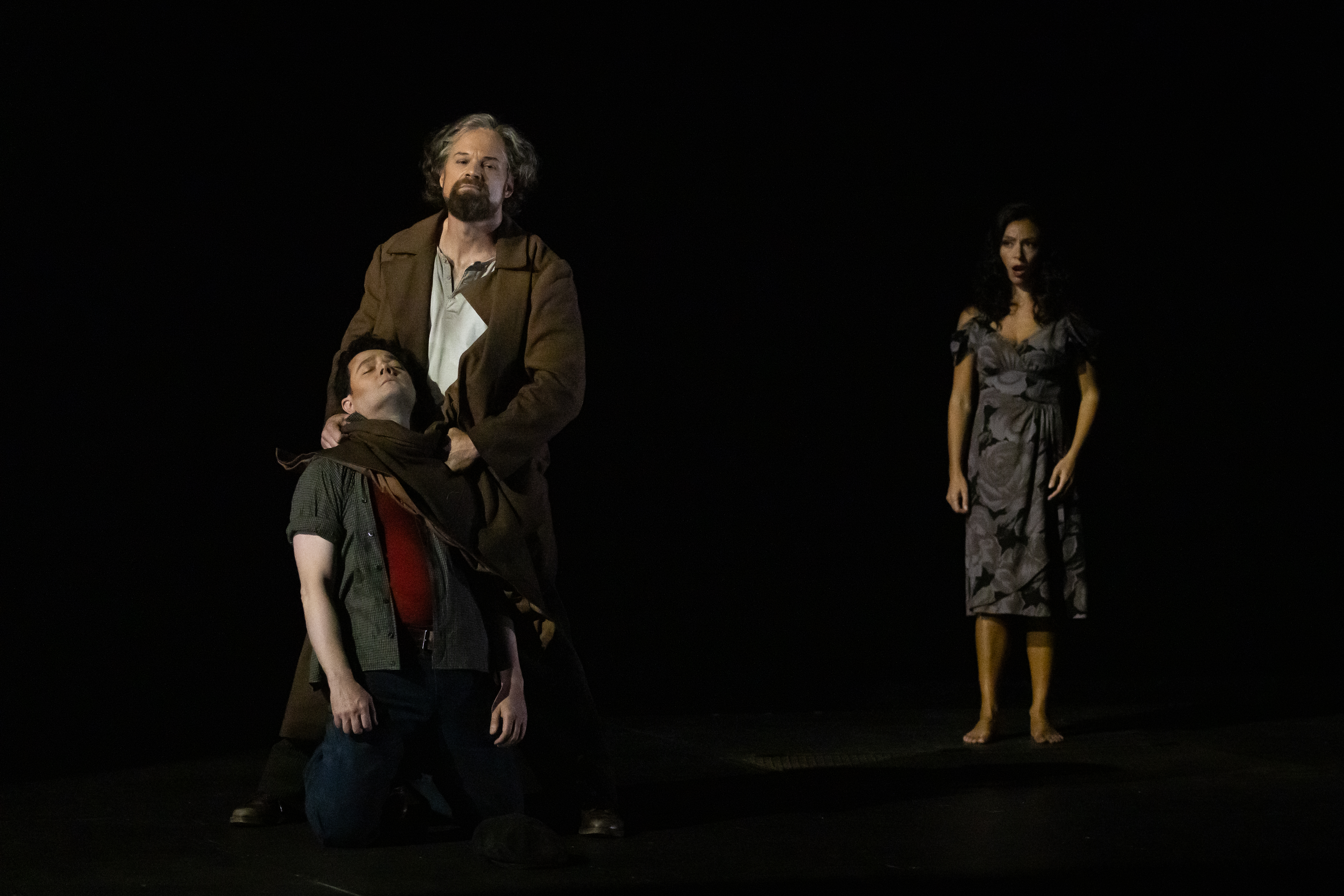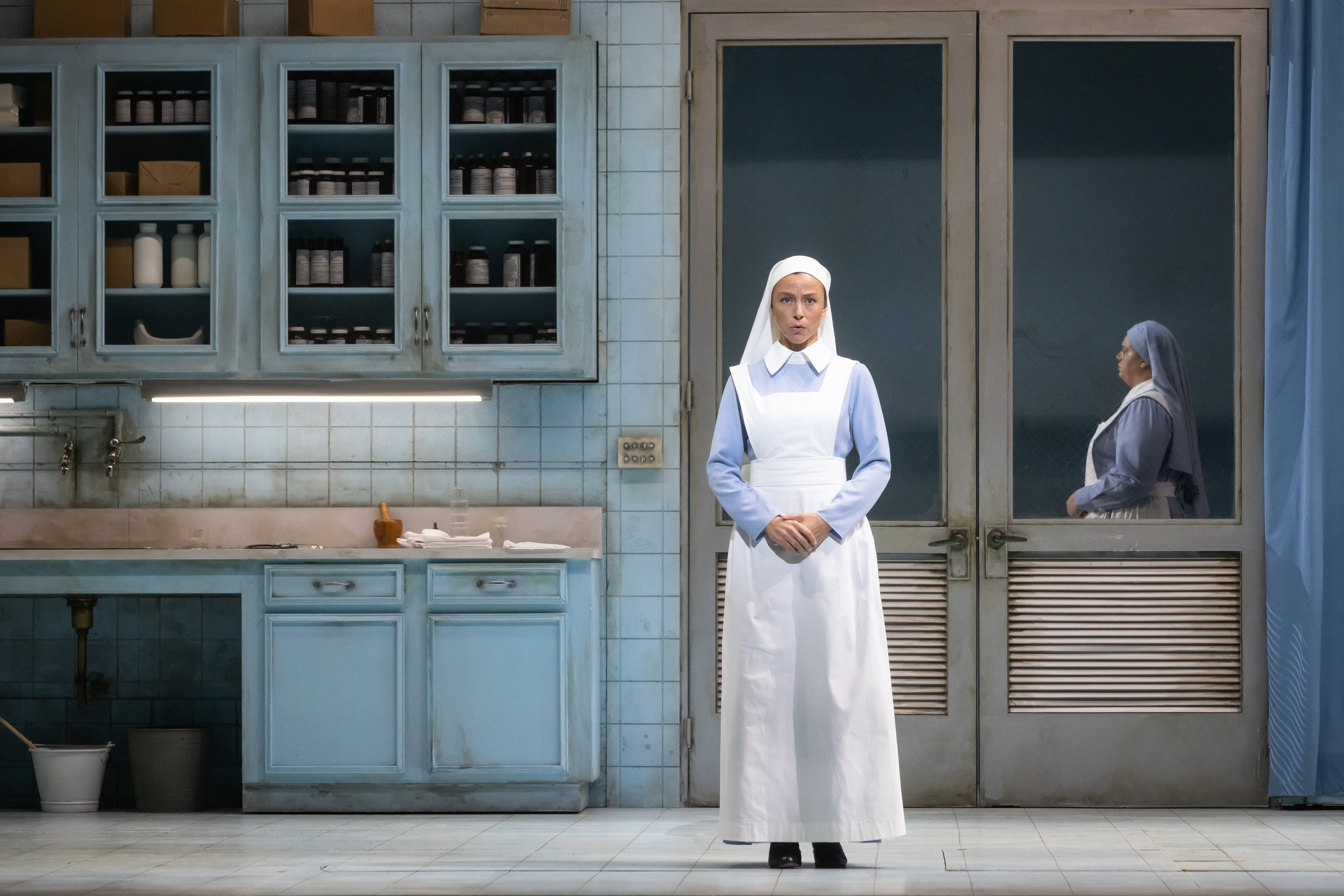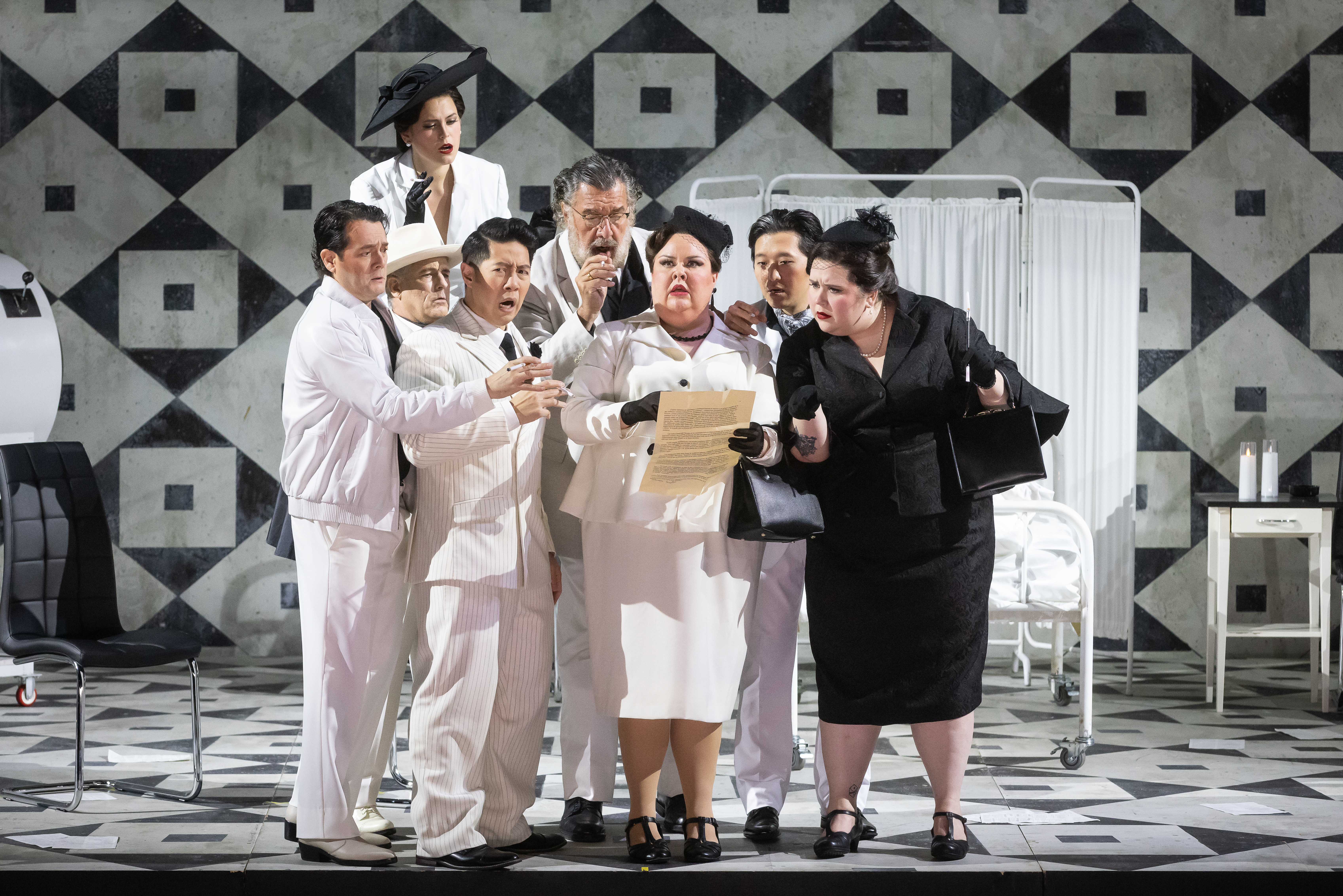Il trittico QUICK START GUIDE
THE OPERA IN ONE SENTENCE
Three thematically connected stories examine the effects of a death on a set of characters: after the passing of their child, Giorgetta falls out of love with her bargeman husband Michele, leading to a jealous murder; Sister Angelica's life is destroyed when she learns that her illegitimate son has died; and Gianni Schicchi helps the greedy Donati family forge the will of their late relative.
BACKGROUND
In 1893, the Metropolitan Opera presented the first double-bill combining Pietro Mascagni’s Cavalleria rusticana and Ruggero Leoncavallo’s Pagliacci—two gritty, one-act dramas in the Italian verismo tradition. Hoping to one-up the success of this pairing with his own 1918 Met premiere, Giacomo Puccini conceived Il trittico as a trio of contrasting one-acters. The title, which translates to “the triptych,” refers to three-paneled paintings that typically serve as altarpieces.
Librettist Giuseppe Adami adapted Il tabarro (The Cloak) from Didier Gold’s 1910 play La houppelande, which belongs to a French horror genre known as Grand-Guignol theater. Suor Angelica (Sister Angelica) is an original scenario by Giovacchino Forzano, who originally wrote the text as a spoken drama. For Gianni Schicchi, Adami invented a backstory for the titular fraudster—a real-life Florentine of the 13th century whom Dante damned to hell in his Inferno. Because of this connection, a popular interpretation of Il trittico (first proposed by Puccini biographer Mosco Carner) compares the three operas to Dante’s journey in the Divine Comedy from the Inferno to Purgatory to Paradise.

WHAT TO LISTEN FOR
Over the flowing orchestral theme that represents the River Seine in Il tabarro, Puccini assembles a collage of Parisian city sounds: a tugboat whistle, car claxons, an out-of-tune barrel organ, and a street musician selling a song about a girl named Mimì (the composer sneaks in a self-quotation from La bohème). During Michele’s vengeful final monologue, “Nulla silenzio,” listen for the jagged, rising motive that musically represents the cloak that will hide his terrible crime.
In composing Suor Angelica, Puccini made a research trip to the convent where his sister was the Mother Superior. Listen for the nuns’ recurring “Regina Virginum” hymn associated with Mary—it’s the basis for a glorious choral finale featuring organ and piano. But the emotional heart of the opera is Angelica’s devastating aria “Senza mamma,” in which she laments her dead son in mournfully descending phrases.
Conceived in the spirit of Italian opera buffa comedies, Gianni Schicchi is an ensemble piece filled with boisterous numbers depicting the Donati family’s bickering and scheming. The work is also a love letter to the city of Florence, which Rinuccio praises in “Firenze è come un albero fiorito,” modeled after a Tuscan stornello folksong. Listen for the opera’s hit aria, “O mio babbino caro,” in which Lauretta begs her father to come to the Donatis’ aid so she can marry Rinuccio.
FUN FACT
Both Rinuccio and Lauretta’s arias are heard on the soundtrack to the 1985 Merchant Ivory film A Room with a View. Based on E.M. Forster’s 1908 novel, the film takes place in Florence and showcases many of the sites mentioned in Gianni Schicchi. During the opening scene, Helena Bonham Carter and Maggie Smith’s characters are disappointed that their pensione room doesn’t overlook the Arno—the river where Lauretta threatens to drown herself in “O mio babbino caro” (sung by Kiri Te Kanawa in the film).
SYNOPSIS
Il tabarro
Original Setting: Paris, River Seine, 1910
As the day comes to a close, a team of stevedores finishes unloading the cargo from Michele’s barge. His young wife Giorgetta rewards them with wine and dances briefly with the handsome worker Luigi, breaking away when Michele suddenly comes up from the hold. La Frugola, a junk collector, arrives to collect her stevedore husband Talpa. She tells Giorgetta of her dream: a place in the country where she, her man, and her cat can retire. Giorgetta responds with her own dream: to abandon her nomadic existence on the river and return to her home suburb of Belleville. After the stevedores disperse, Giorgetta and Luigi secretly agree to meet once Michele falls asleep—Giorgetta will light a match as the signal.
Left alone with Giorgetta, Michele tries to reach his estranged wife. He reminds her of happier nights—how, when their little boy was still alive, Michele used to wrap Giorgetta and the child up in his cloak. Giorgetta descends into the cabin, and Michele explodes with jealousy. Certain that his wife is unfaithful, he vows revenge on whichever man has alienated her affections. As he ruminates, he lights his pipe, which Luigi—hiding in the shadows—mistakes for Giorgetta’s signal. He bounds onto the barge, only to meet Michele, who forces him to admit his guilt before slitting his throat. Michele conceals Luigi’s corpse beneath his cloak when Giorgetta comes on deck and cruelly confronts his wife with the body of her dead lover.

INTERMISSION
Suor Angelica
Original setting: Italian convent, late 17th century
A community of nuns assembles after chapel to discuss the miraculous sign from the Virgin that greets them every year on this evening: a ray from the setting sun illuminates their fountain. Their conversation turns into a debate over whether it’s sinful to desire, and they whisper about Sister Angelica, whom they know is harboring a secret wish to hear from her noble family. Just then, the infirmary sister enters seeking relief for a nun who has been stung by wasps. Angelica, who has knowledge of herbs and flowers, quickly mixes up a salve.
A grand carriage arrives, and the Abbess announces that the visitor is Angelica’s aunt, the Princess. The two relatives are left alone, and the Princess reminds her niece that she’s there to atone: seven years earlier, Angelica brought shame on the family by having a child out of wedlock. Angelica’s sister is getting married, and the Princess needs the nun to sign over her inheritance to the bride-to-be. Frustrated by her aunt’s coldness, Angelica demands to know about the son who was taken from her. The Princess informs her that the boy died of an illness two years earlier. Devastated by the news, Angelica prepares a poison from her plants so that she can join her child in heaven. But having drunk the draught, she realizes she’s committed the unpardonable sin of suicide and begs the Virgin for forgiveness. In her dying moments, she witnesses a vision that promises redemption.

INTERMISSION
Gianni Schicchi
Original setting: Florence, 1299
The members of the noble Donati clan are assembled in the home of the family patriarch, Buoso, who has just passed away. But their grief soon turns to rage when they discover his will: Buoso has left his entire fortune to a monastery. Rinuccio Donati summons the city’s shrewdest citizen, his girlfriend Lauretta’s father, Gianni Schicchi. The Donatis object to taking advice from a commoner who isn’t originally from Florence. And the animosity is mutual—when Schicchi arrives with Lauretta, he refuses to help the money-grubbing family. But Lauretta begs her father to intercede. Without a dowry, Rinuccio’s Aunt Zita won’t allow him to marry Lauretta.
Swayed by his daughter, Schicchi reluctantly agrees and hatches a macabre plot. Posing as Buoso—whose death is still unknown outside the room—he dictates a new will to the notary, equally dividing the deceased’s properties among the Donatis. But they’re unable to stop Schicchi from appending one additional beneficiary: he leaves Buoso’s Florentine residence to himself. After the notary departs, Schicchi chases the Donatis out of what is now his house. Lauretta and Rinuccio bask in their love as they marvel at the heavenly view of Florence. Addressing the audience directly, Schicchi asks whether Dante was right to damn him to hell in the Inferno when his little crime guaranteed such happiness.

HGO PERFORMANCE HISTORY
HGO previously performed Il tabarro in the 1962-63 season and Gianni Schicchi in the 1957-58 and 1969-70 seasons.